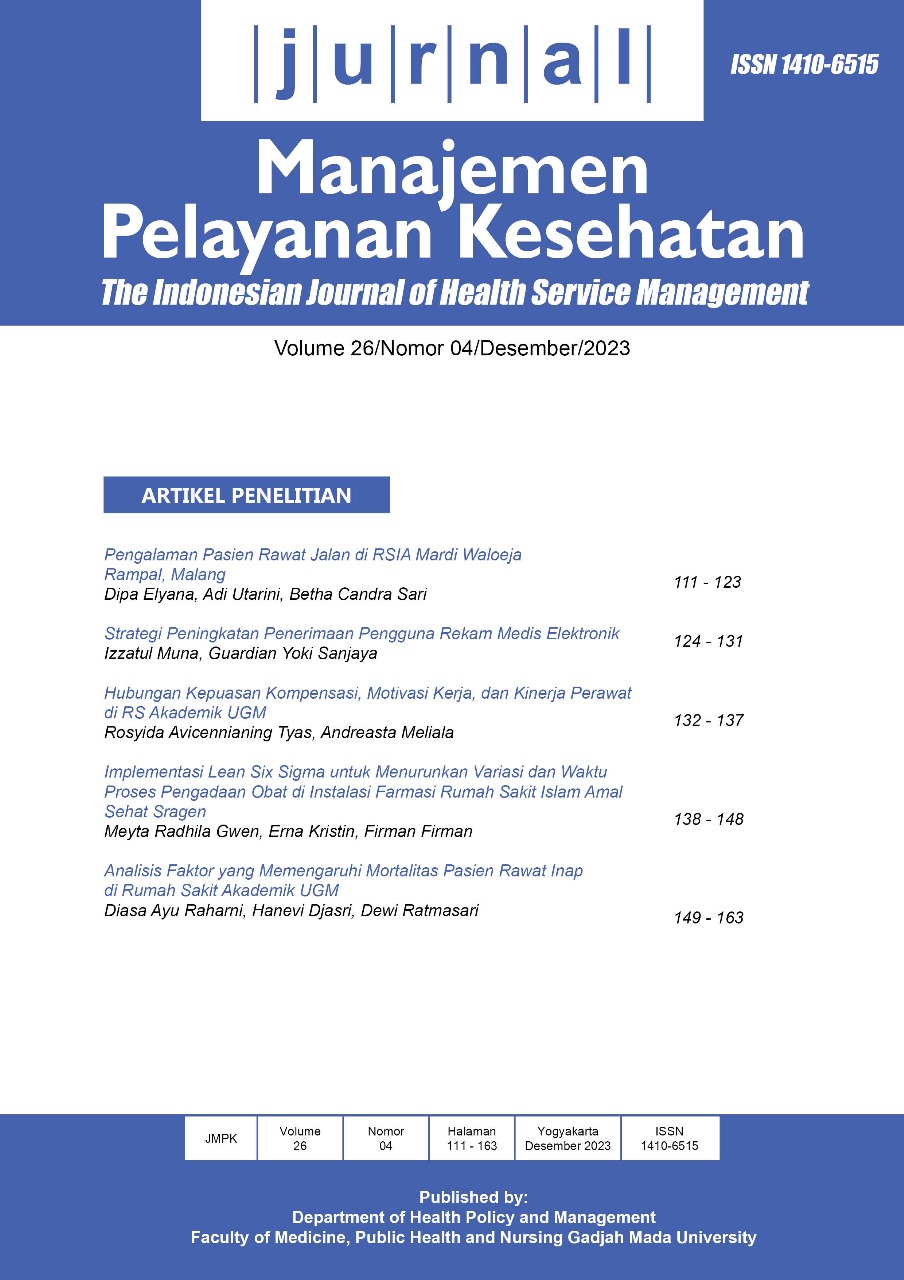ANALISIS FAKTOR YANG MEMENGARUHI MORTALITAS PASIEN RAWAT INAP DI RUMAH SAKIT AKADEMIK UGM
Abstract
Background: Hospital mortality indicators are important element of a hospital patient safety monitoring program. In 2022, the record of inpatient performance at RS Akademik UGM (RSA UGM) shows that the NDR value has not yet reached the ideal standard, namely 34.1‰.
Objective: Identifying factors that influence the mortality rate of adult patients ≥48 hours in inpatient care and developing a program plan to reduce hospital mortality at RSA UGM.
Methods: An explanatory sequential design of mixed methods research was used. The medical records of adult patients admitted to RSA UGM from October 2022 to December 2022. Quantitative data analysis used chi-square, Fisher’s exact tests and multivariate logistic regression. Qualitative data was obtained from focus group discussions with three separate groups, namely the managerial group, the doctor team and the nurse team., while qualitative data used thematic analysis.
Results: 388 subjects were obtained with 18 (4.64% or 46.4‰) patients died during treatment ≥48 hours. Independently, ward type (OR 10,799, CI 95 % 3,990 – 29,233), EWS score (OR 15,644, CI 95 % 5,511 – 44,412) and number of comorbidities (OR 8,603, CI 95 % 2,769 – 26,730) associated with with ≥48 hours in-hospital mortality (<0.001). Multivariate analysis showed that ward type (p=0.018, aOR 4,122, CI 95 % 1,279 – 13,284) and early warning system (EWS) score (p=0.016, aOR 4,531, CI 95 % 1,327 – 15,469) had a strong association with ≥48 hours in-hospital mortality. Qualitative results show that the problems faced daily related to the increasing death rate are the high complexity of patients, inadequate ICU facilities and inadequate human resource competency; the proposed program to reduce inpatient mortality by improving clinical management in intensive care, improving the competency and skills of doctors and nurses, and increasing the effectiveness of the early warning system.
Conclusion: The EWS score >5 and the intensive care are significantly related to in-hospital mortality ≥48 hours after hospitalization so it is important for management to improve the quality of services at the RSA UGM by carry out a strategy to reduce hospital mortality rates in order to decrease the net mortality rate in accordance with the Ministry of Health’s national standards.
References
Australian Commission on Safety and Quality in Health Care. Using Hospital Mortality Indicators to Improve Patient Care : A guide for Boards and Chief Executives. ACSQHC.
Whittington J, Simmonds T, Jacobsen D. Innovation Series: Reducing Hospital Mortality Rates (Part 2). Cambridge, 2005. Epub ahead of print 2005. DOI: 10.1016/s0300-7073(12)70473-5.
Khasanah N, Fadillah N, Sari I. Analisis Deskriptif Indikator Gross Death Rate (Gdr) Dan Net Death Rate (Ndr) Di Rumah Sakit X Pada Tahun 2016-2020. Media Bina Ilm 2022; 16: 7639–7646.
Walicka M, Puzianowska-Kuznicka M, Chlebus M, et al. Relationship between age and in-hospital mortality during 15,345,025 non-surgical hospitalizations. Arch Med Sci 2021; 17: 40–46.
Langkjaer CS, Bundgaard K, Bunkenborg G, et al. How nurses use National Early Warning Score and Individual Early Warning Score to support their patient risk assessment practice: A fieldwork study. J Adv Nurs 2023; 79: 789–797.
Gielen A, Koekkoek K, van der Steen M, et al. Evaluation of the initial general ward early warning score and ICU admission, hospital length of stay and mortality. West J Emerg Med 2021; 22: 1131–1138.
Soffer S, Klang E, Barash Y, et al. Predicting In-Hospital Mortality at Admission to the Medical Ward: A Big-Data Machine Learning Model. Am J Med 2021; 134: 227-234.e4.
Wallis CB, Davies HTO, Shearer AJ. Why do patients die on general wards after discharge from intensive care units? Anaesthesia 1997; 52: 9–14.
Kachingwe M, Kayambankadzanja RK, Mwafulirwa WK, et al. Factors associated with in-hospital mortality of patients admitted to an intensive care unit in a tertiary hospital in Malawi. PLoS One 2022; 17: 1–13.
Unal AU, Kostek O, Takir M, et al. Prognosis of patients in a medical intensive care unit. North Clin Istanbul 2015; 2: 189–195.
Town JA, Churpek MM, Yuen TC, et al. Relationship between ICU bed availability, ICU readmission, and cardiac arrest on the general wards. Crit Care Med 2015; 42: 2037–2041.
Toscani F, Di Giulio P, Brunelli C, et al. How people die in hospital general wards: A descriptive study. J Pain Symptom Manage 2005; 30: 33–40.
Rizzuto D, Melis RJF, Angleman S, et al. Effect of Chronic Diseases and Multimorbidity on Survival and Functioning in Elderly Adults. J Am Geriatr Soc 2017; 65: 1056–1060.
Chong WF, Ding YY, Heng BH. A comparison of comorbidities obtained from hospital administrative data and medical charts in older patients with pneumonia. BMC Health Serv Res; 11. Epub ahead of print 2011. DOI: 10.1186/1472-6963-11-105.
Behal R, Finn J. Understanding and improving inpatient mortality in academic medical centers. Acad Med 2009; 84: 1657–1662.
Wright J, Dugdale B, Hammond I, et al. Learning from death: A hospital mortality reduction programme. J R Soc Med 2006; 99: 303–308.
Mueller JT, Thiemann KMB, Lessow C, et al. The Mayo Clinic Hospital Mortality Reduction Project : Description and Results. J Healthc Manag 2020; 65: 122–132.
Pratama BA, Parmadi A. Trend Gross Death Rate and Net Death Rate per year at PKU Muhammadiyah Hospital in Surakarta in 2011-2015. IJMS-Indonesian J Med Sci 2017; 4: 196–201.
Okoroiwu HU, Uchendu KI, Essien RA. Causes of morbidity and mortality among patients admitted in a tertiary hospital in southern Nigeria: A 6 year evaluation. PLoS One 2020; 15: 1–15.
Porcel-Gálvez AM, Barrientos-Trigo S, Gil-García E, et al. Factors associated with in-hospital mortality in acute care hospital settings: A prospective observational study. Int J Environ Res Public Health 2020; 17: 1–10.
Omar SM, Osman OS, Gasim GI, et al. Pattern and Trends in Adult Hospitalization/ Admission and Mortality Among Medical Ward Inpatients at Gadarif Hospital in Eastern Sudan: A Four-Year Retrospective Study. Int J Gen Med 2022; 15: 5879–5889.
Wieczorek-Wojcik B, Gaworska-Krzemińska A, Owczarek AJ, et al. In-hospital mortality as the side effect of missed care. J Nurs Manag 2020; 28: 2240–2246.
Vollam S, Gustafson O, Young JD, et al. Problems in care and avoidability of death after discharge from intensive care: a multi-centre retrospective case record review study. Crit Care 2021; 25: 1–10.
Ala S, Pakravan N, Ahmadi M. Mortality Rate and Outcome among Patients Admitted to General Intensive Care Unit during “Morning-Hour” Compared with “Off-Hour”. Int J Clin Med 2012; 03: 171–177.
Antonio e Silva LG, Dantas de Maio Carrilho CM, Talizin TB, et al. Risk factors for hospital mortality in intensive care unit survivors: a retrospective cohort study. Acute Crit Care 2023; 38: 68–75.
Abedin M, Abedin M, Uddin A, et al. Death Audit An Experience In Medicine Ward. J Bangladesh Coll Physicians Surg 2014; 32: 138–141.
Loisa E, Kallonen A, Hoppu S, et al. Trends in the national early warning score are associated with subsequent mortality – A prospective three-centre observational study with 11,331 general ward patients. Resusc Plus 2022; 10: 100251.
Magdalena M, Monika H, Ciril B, et al. Association of in-hospital multimorbidity with healthcare outcomes in Swiss medical inpatients. Swiss Med Wkly 2021; 151: 1–11.
Chanda SL, Liusha N, Chansa A. Medical Ward In-Patient Mortality Patterns at a Tertiary Hospital in Urban Zambia: A One Year Review June 2018-June 2019. Med J Zambia 2020; 47: 132–142.
Tseng CL, Hsu NC, Hsieh PI, et al. Integrated approach for multimorbid patients in a hospitalist setting: Survival analysis of a two-year prospective study. J Formos Med Assoc 2022; 121: 473–481.
Manadan A, Arora S, Whittier M, et al. Patients admitted on weekends have higher in-hospital mortality than those admitted on weekdays: Analysis of national inpatient sample. Am J Med Open 2023; 9: 100028.
Gibson JME. Focus of nursing in critical and acute care settings: Prevention or cure? Intensive Crit Care Nurs 1997; 13: 163–166.
Bihari S, McElduff P, Pearse J, et al. Intensive care unit strain and mortality risk in patients admitted from the ward in Australia and New Zealand. J Crit Care 2022; 68: 136–140.
Santos AC, de Oliveira SLF, Macedo VLM, et al. Intensive Care Unit prioritization: The impact of ICU bed availability on mortality in critically ill patients who requested ICU admission in court in a Brazilian cohort. J Crit Care 2021; 66: 126–131.
Tian Y, Yao Y, Zhou J, et al. Dynamic APACHE II Score to Predict the Outcome of Intensive Care Unit Patients. Front Med; 8. Epub ahead of print 2022. DOI: 10.3389/fmed.2021.744907.
Ko M, Shim M, Lee SM, et al. Performance of APACHE IV in medical intensive care unit patients: Comparisons with APACHE II, SAPS 3, and MPM0 III. Acute Crit Care 2018; 33: 216–221.
Widyastuti Y, Zaki WA, Widodo U, et al. Predictive accuracy of the APACHE IV scores on mortality and prolonged stay in the intensive care unit of Dr Sardjito Hospital. Med J Malaysia 2022; 77: 53–58.
Mumtaz H, Ejaz MK, Tayyab M, et al. APACHE scoring as an indicator of mortality rate in ICU patients: a cohort study. Ann Med Surg 2023; 85: 416–421.
Mythri H, Kashinath K. Nosocomial infections in patients admitted in intensive care unit of a Tertiary Health Center, India. Ann Med Health Sci Res 2014; 4: 738.
Bloomer MJ, Fulbrook P, Goldsworthy S, et al. World Federation of Critical Care Nurses 2019 Position Statement: Provision of a Critical Care Nursing Workforce. Connect World Crit Care Nurs 2019; 13: 3–7.
Esper AM, Arabi YM, Cecconi M, et al. Systematized and efficient: organization of critical care in the future. Crit Care 2022; 26: 1–7.
Kim Y, Kim SH. The Relationship of Nurse and Physician Staffing in Intensive Care Units with Patient Outcomes in Postoperative Patients on Ventilators: An Analysis Using Korean National Health Insurance Data. Healthc; 11. Epub ahead of print 2023. DOI: 10.3390/healthcare11081124.
Beane A, De Silva AP, De Silva N, et al. Evaluation of the feasibility and performance of early warning scores to identify patients at risk of adverse outcomes in a low-middle income country setting. BMJ Open; 8. Epub ahead of print 2018. DOI: 10.1136/bmjopen-2017-019387.
Swami T, Shams A, Mittelstadt M, et al. Implementation of early warning system in the clinical teaching unit to reduce unexpected deaths. BMJ Open Qual 2023; 12: 1–6.
NCEPOD. Themes and Recommendations Common to all Hospital Specialities, www.hqip.org.uk/national-programmes (2018).
Dijkema LM, Dieperink W, Van Meurs M, et al. Preventable mortality evaluation in the ICU. Crit Care; 16, http://ccforum.com/content/16/2/309 (2012).
Matsushima A, Kawanami M, Fujimi S, et al. Effects of infection control bundle to prevent nosocomial infection in the ICU. Crit Care 2015; 19: 83.
Gupta S, Al Khaleefah F, Al Harbi I, et al. An intervention study for the prevention and control of health care-associated infection in the critical cares area of a tertiary care hospital in Saudi Arabia. Indian J Crit Care Med 2018; 22: 858–861.
Blot S, Ruppé E, Harbarth S, et al. Healthcare-associated infections in adult intensive care unit patients: Changes in epidemiology, diagnosis, prevention and contributions of new technologies. Intensive Crit Care Nurs; 70. Epub ahead of print 2022. DOI: 10.1016/j.iccn.2022.103227.
Rosenberger LH, Hranjec T, Politano AD, et al. Effective cohorting and ‘superisolation’ in a single intensive care unit in response to an outbreak of diverse multi-drug-resistant organisms. Surg Infect (Larchmt) 2011; 12: 345–350.
Fukuda T, Sakurai H, Kashiwagi M. Impact of having a certified nurse specialist in critical care nursing as head nurse on ICU patient outcomes. PLoS One 2020; 15: 1–9.
Gundo R, Gundo B, Chirwa E, et al. Effect of an educational programme on critical care nurses’ competence at two tertiary hospitals in Malawi. Malawi Med J 2021; 33: 236–241.
Burchardi H, Moerer O. Twenty-four hour presence of physicians in the ICU. Crit Care 2001; 5: 131–137.
Van der Sluijs AF, van Slobbe-Bijlsma ER, Chick SE, et al. The impact of changes in intensive care organization on patient outcome and cost-effectiveness-a narrative review. J Intensive Care 2017; 5: 1–8.
Netzer G, Liu X, Shanholtz C, et al. Decreased mortality resulting from a multicomponent intervention in a tertiary care medical intensive care unit. Crit Care Med 2011; 39: 284–293.
Qolbi NQY, Nursalam N, Ahsan A. Knowledge and Skill in Relation to the Speed and Accuracy of the Nurses When Assessing Using an Early Warning System (EWS). J Ners 2020; 15: 531–537.
Raj A, Zwaal J. Impact of training in the use of an early warning system on in-hospital cardiac arrests. Crit Care 2011; 15: 477.
Saab MM, McCarthy B, Andrews T, et al. The Effect of Adult Early Warning Systems Education on Nurses’ Knowledge, Confidence, and Clinical Performance: A Systematic Review. J Adv Nurs 2017; 73: 2506–2521.
Na SJ, Ko RE, Ko MG, et al. Automated alert and activation of medical emergency team using early warning score. J Intensive Care 2021; 9: 1–9.
Escobar GJ, Liu VX, Schuler A, et al. Automated Identification of Adults at Risk for In-Hospital Clinical Deterioration. N Engl J Med 2020; 383: 1951–1960.
Silva LMA, Moroço DM, Pintya JP, et al. Clinical impact of implementing a rapid-response team based on the modified early warning score in wards that offer emergency department support. PLoS One 2021; 16: 1–12.
Wu CL, Kuo CT, Shih SJ, et al. Implementation of an electronic national early warning system to decrease clinical deterioration in hospitalized patients at a tertiary medical center. Int J Environ Res Public Health; 18. Epub ahead of print 2021. DOI: 10.3390/ijerph18094550.
Hogan H, Hutchings A, Wulff J, et al. Type of Track and Trigger system and incidence of in-hospital cardiac arrest: an observational registry-based study. BMC Health Serv Res 2020; 20: 1–9.
Copyright (c) 2024 Diasa Ayu Raharni, Hanevi Djasri, Dewi Ratmasari

This work is licensed under a Creative Commons Attribution-NonCommercial-ShareAlike 4.0 International License.




